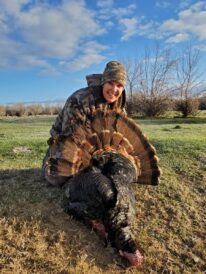Utah Wildlife Board Approves key updates to rules for wildlife access, guides, hunting programs, and more

November is a great time to see buck deer at the Nash Wash Wildlife Management Area.
Utah’s Wildlife Board has approved a series of changes impacting wildlife management area (WMA) access, outfitter regulations, hunting programs, conservation permits, and game bird management following a public meeting held Thursday. The updates come in response to recent legislative changes and ongoing efforts to streamline wildlife conservation and recreation programs across the state.
WMA License Rule Clarified for Four Northern Utah Counties
Following a new law passed during the 2025 Utah legislative session, anyone 18 years or older must now hold a valid hunting, fishing, or combination license to access WMAs or waterfowl management areas in Davis, Salt Lake, Utah, and Weber counties — designated as “class one” or “class two” counties.
The Utah Wildlife Board added clarifying exemptions to the new requirement, including:
- Educational exemptions for locations such as the George S. and Dolores Doré Eccles Wildlife Education Center and the Great Salt Lake Hasenyager Reserve.
- Exemptions for DWR staff, contractors, volunteers, and federal land managers while conducting official duties.
- Sovereign lands and specific conservation commission properties — including Provo River Delta, Diamond Fork, and Utah Lake Wetland Preserve — are also excluded from the requirement.
“These areas are not multi-use recreational lands,” said Chelsea Duke, Lands Coordinator for the Utah Division of Wildlife Resources. “They are specifically managed for wildlife habitat conservation and are primarily funded by license sales and federal excise taxes — not state taxes.”
More information about WMAs requiring licenses is available on the DWR website.
Guides, Outfitters, and Spotters Now Regulated by DWR
A major shift also took place in how hunting guides, outfitters, and spotters are regulated. A new law passed earlier this year transfers oversight from the Utah Division of Professional Licensing to the DWR and DNR Law Enforcement.
New rules approved by the board include:
- An annual certificate of registration, due by March 31, for guides, outfitters, and spotters who are paid to assist in hunting or fishing.
- Field requirements, such as limits on the number of guides assigned to each client — no more than two for general hunts and three for once-in-a-lifetime species.
- Clear guidelines for violations, prohibited activities, and how federal permits should be obtained.
The changes go into effect July 1. Application and fee details are posted on the DWR website.
Dedicated Hunter Program Gets Expanded Service Credit Option
The board also approved updates to Utah’s popular Dedicated Hunter Program, which allows eligible participants to hunt deer over multiple seasons in exchange for conservation service.
Starting January 1, 2026, individuals applying to the program can earn service hours before officially enrolling, provided the hours:
- Are completed on DWR-approved projects
- Occur between January 1 and the big game draw result date
- Are completed in the same year as the application
Service hours completed early won’t roll over into future years, and any excess hours — performed or purchased — remain nontransferable and nonrefundable.
Additional administrative changes clarify what happens when a hunt is canceled or when a unit is discontinued.
Conservation Permit Program Sees Tweaks
The Conservation Permit Program, which helps raise money for wildlife projects by allowing groups to auction off limited-entry tags, was also updated:
- The Dec. 31 season extension for bighorn sheep units has been eliminated.
- The requirement for a conservation permit on Antelope Island for every public tag was removed.
- The Utah Wildlife Board will now officially approve the permits and dates as part of their agreement with Utah State Parks.
Conservation groups continue to allocate 90% of funds from permit auctions to wildlife projects like habitat restoration and species surveys.
New Public Land Approvals for Private CWMUs
Utah’s Cooperative Wildlife Management Unit (CWMU) program — which allows private landowners to provide regulated hunting on their land — received approval for four applications that include some public land use. The board approved two new and two renewed requests for 2025, continuing the program’s success in opening over 2 million acres of private land to hunters.
Sage-Grouse Translocations Approved
To support declining greater sage-grouse populations, the board approved translocations from the Blue, Diamond, and Parker Mountains into three areas:
- Tidwell Slopes/Mytoge Mountain (Parker SGMU)
- Tabby Mountain (Strawberry SGMU)
- Browns Park (Uintah SGMU)
This marks the first sage-grouse relocation effort in Utah since 2019, and aims to restore populations in historically occupied areas.
Pen-Reared Game Bird Rules Updated
Several updates were made to regulations for those raising and releasing pen-reared game birds, including:
- Facilities with 1,000+ birds or eggs (held for 60+ days) must now obtain a commercial license from the Utah Department of Agriculture and Food.
- Avian influenza testing must occur quarterly or 30 days before release, with test documentation provided by sellers.
- Mycoplasma testing is no longer required, but random DWR sampling will continue.
- Releasing birds with visible disease symptoms is now explicitly prohibited.
Leadership Changes for Wildlife Board
The board announced Gary Nielson will serve as the new chair of the Utah Wildlife Board, taking over from Randy Dearth, whose term ends in August. Paula Richmond was named as the new vice chair.
For those who wish to view the full public meeting, it is available on the Utah Department of Natural Resources YouTube channel.



